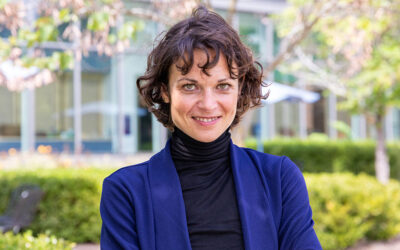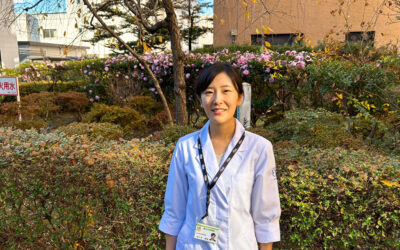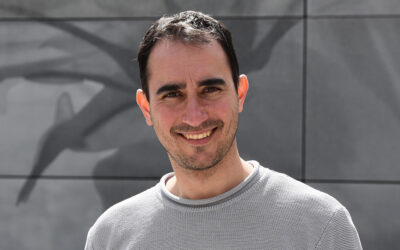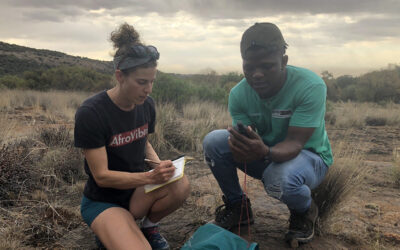Our interview with Professor Madhu Bhaskaran could not have happened at a better time. Coincidentally, this month the Nobel Prize for Physiology or Medicine was awarded to Professors David Julius and Ardem Patapoutian who discovered the inner workings of pain, heat and pressure sensing in the human skin.
The laboratory that Bhaskaran co-leads with her husband Professor Sharath Sriram has built an artificial version of these sensors in order to create an electronic skin with pain-sensing ability comparable to that of a human skin.
Bhaskaran has a passion for creating devices that simplify the assessment of vital signs or the patient’s presence without strong interference and disturbance. This is being achieved by placing the device in a mattress, for example, where it can determine the sleeping position of an elderly patient in order to prevent a potential fall out of bed.
We spoke to Bhaskaran about her impressive career path, how she handled roadblocks and which devices she plans to build in the future.
Please tell us a bit about yourself. Where did you grow up and when did you decide to become an engineer?
I grew up in a city called Chennai in South India and I’m actually the product of two medical doctors. Their dream and vision for me was to become a medical doctor as well. I remember when I was growing up and I was three, I used to call myself Dr. Madhu because I just thought everyone had the title of “doctor”. It turns out I did become a doctor, but not that kind of a doctor.
I was growing up in the 90s and that was a time when we started getting computers in the house. Telephones were undergoing a massive evolution from becoming corded, to cordless, to mobile phones. I was really fascinated to understand how electronics are so miniaturized and how they keep working, and that’s what drew me to becoming an electronics engineer. When I had to choose between medicine and engineering, I chose engineering.
Did you have an important mentor or mentors who inspired and supported you?
The credit goes to my mom because she put a competitive spirit in me and it is really a self-driven spirit in some sense. It has always been me driving myself in a particular direction. I don’t think I really understood the meaning of the word ‘mentor’ until I came here and did a PhD. After my early career as a researcher, I started having a few mentors in different spaces to talk about my leadership journey, not so much to talk about my research career path. So, I do have a few people I touch base with and talk to but it’s on different aspects, not the typical career mentorship which most people have.
More than mentors, I almost always had sponsors, people looking out for me all the time like Dr. Cathy Foley. She is Chief Scientist of Australia and before that, she was Chief Scientist at the CSIRO [Commonwealth Scientific and Industrial Research Organisation]. She was someone I met at an event and then from there I could always turn to her for support, for advice and also to get recommendation letters, which you need practically all the time. There is also Professor James Friend who is now with UCSD [University of California San Diego]. I met him when he was in Melbourne and again he has been this constant person whom I could always turn to for support and for any advice for applications and such.
Was it always smooth sailing or was there ever a phase where you thought about doing something else?
Not really. I think in some ways I was living the phrase “ignorance is bliss.” I don’t think I really thought ahead too far at certain stages in my career. When I look back today, I think “Wow that was gutsy” to just keep assuming and believing that things will fall in place and keep going in a particular direction. Obviously in the beginning I was just going from one short term contract after another and there was not much career stability.
There was a time I was really questioning myself and that was when my husband and I wanted to start a family and we wanted to buy a house but both of us are academics, so both of us were on these floating contracts and we just didn’t know what was on the horizon past the end of the year. How do we make sure that at least one of us lands a more stable position so we can start planning our lives around that? That was the time when I was thinking ‘what’s next’ and ‘what do I do next’ but then I was empowered to at least have the right conversation.
The place where I work, RMIT University, has a much looser hierarchy than other institutions. Anyone can go and talk to anyone. I remember emailing the head of the school and having this conversation with him and saying, “I’m a person at this stage in my career who also has to make life choices. Can he do something about that?” There are two of us here, not just one of us, and we really needed answers because we needed to understand what to do. He was very understanding and he then considered me for an ongoing position and that offered some career stability. It was very gutsy thinking about it now, but I am glad I did talk to the head of the school, because he immediately saw what I needed and that he could give me a way out of that situation.
What advice would you give aspiring engineers who are just beginning to pursue this profession?
It is a fantastic profession. I love the fact you can invent solutions to people’s problems. It involves being innovative and inventive all the time and finding problems and then offering solutions to people. I think no matter what branch of engineering you choose, you will always have to find a solution to some problem in the world, so just go for it.
You are currently a Professor at RMIT. Can you tell us about your laboratory: the Functional Materials and Microsystems Research Group?
I co-established, and I am co-leading this research group with my husband. The group is now 11 years old. We established the group with just two people and now it has grown into a group of nearly 45 members. There has been phenomenal growth in terms of personnel as well as capacity and capability. It has a pretty broad name because three of us now co-lead the group. We work with everything micro and nano in terms of materials and then because we are engineers, we try and put them to use for different applications.
For the last few years, a lot of focus has been on working closely with industry. So, it’s not just about doing the laboratory research, publishing it in the highest impact factor journal and then leaving it at that. I think right from the beginning we have been very conscious of doing science communication and making sure we do the outreach and to talk about our research in layman’s terms. We were also trying to see if we can work with industry and get those technologies out into the real world. In the last few years, a lot of our work [has been] predominantly in the wearables space for healthcare and aged care.
You have used stretchable electronics to create an electronic skin that senses pain like human skin. The skin consists of stretchable electronics, temperature-reactive coatings and brain-mimicking memory. What materials are used to create the different skin components and what sets them apart from other materials?
We were stoked to see the Nobel Prize [in medicine] and to see what we created was literally the electronic, or the artificial equivalent, of those somatosensors. I think we imagine this as literally skin which you can put on prosthetics, and it behaves like real skin. Our focus is making sure we use materials which can sense actual stimuli, so it’s not a modified stimulus, it’s actual heat and actual pressure which the skin is sensing.
We also think about the brain when making electronics, so we are able to mimic the entire system from the skin communicating with the brain and then the brain sending back a response to the skin to behave in a certain specific manner. They are all inorganic materials in terms of the sensing layers, predominantly oxides, but the skin on which they’re sitting is a silicone rubber or a contact lens material. It is stretchable and very similar to human skin and you can easily imagine wrapping something like that on prosthetics and helping it give the full lifelike experience.
I think the uniqueness [of our work] is also that we can control the threshold[s involved in sensing]. If, for instance, the skin is sunburnt, then it reacts very differently to stimuli [compared to normal healthy skin]. There are also people who suffer from hyperalgesia or allodynia and they react very differently to stimuli. You can control all that in the electronic skin version by controlling the thresholds for sensing to give you the ability to really mimic the way skin behaves.
Tell us about the other sensors you have created so far. What is the working principle of these devices?
Quite a few of our sensors are actually [made] in collaboration with industry, so we work with a lot of wearables and these typically measure biometrics in the body. It could be measuring your skin temperature, your ECG and more. We also have other biosensors which pick up various biomarkers in our body fluids. This would include testing saliva for various biomarkers or other body fluids like tears, saliva or sweat.
When we first started this research, our focus was to monitor external things in the environment, for example getting or keeping tabs on how much UV exposure you have on a day-to-day basis. That is very important in Australia, where skin cancer [rates are] extremely high. How can you make sure somebody can wear a little patch on their skin and that will alert them to go and put on more sunscreen? One of our industry projects worked on individual differences. We are all different and we all have different skin types. Taking that diversity in the population into account every time we create our technologies is something which we are really proud to do.
Can your sensors be worn by anybody or is there a customization step involved to ensure a perfect fit?
For us it is extremely important that the person who is wearing the sensor is comfortable wearing it and also loves wearing it. It is not about wearables looking clunky and wearing it just because you have to wear it. We want you to want to wear it.
We work quite closely with our design colleagues, so there is always user customization. It is not a one size fits all model, but almost a platform technology where you can change the sensor based on what a person wants by changing the feel and the look.
How long does it take from conceptualization to final “ready-to-use” product?
It depends. Developing fundamental aspects of our platform took us nearly three years. Our motivation was to create unbreakable electronics and it took us around 3 to 3 and a half years to come up with the entire process and the technology (which is quite versatile) and then to patent it. It took us a while to find the right industry partners to start this journey and take it out into commercialization and that is a further two- or three-year journey. If everything is lined up and the money is lined up and the right people are lined up, you probably can go from a very early concept to actually a product which is hitting the market in a span of eight to nine years.
How long would the customization step for every single patient take in addition to that?
I would say bring them in as soon as you start working the industry partners so you are all on the same page and then we truly understand the shape of everything. This includes the shape of your wearable, the feel of it, where you put it on your body and more. We assume a lot and then we realize it is not quite what people want, so having them early in the process really helps to perfect it as soon as it hits the market.
We work with a person called Dr. Leah Heiss, a design researcher, who typically creates user scenarios and chooses a population of 6 to 10 people as diverse as they can be from age, gender, their way of life, their affordability of the technology and what their profession might be. Are they using this particular piece at home or are they on the go all the time? Everything will change based on those requirements.
What sensors are you planning to develop next?
We have quite a few being planned with industry partners. One of them is a new wearable which we call a ‘nearable’ because it’s essentially a sensor which goes into a mattress. If this is placed in a residential aged care home, you could have an indication of a person’s presence, posture and position on the bed. It’s a good way to prevent falls through the night because the person who’s looking after them is typically looking after 10 or 15 rooms at a given time. That person will have a dashboard which clearly shows them if there is a risk of someone falling out of the bed or if this person went to use the restroom, but it’s been 20 minutes and they have not come back. We also have the ability to monitor other biometrics as well like their heart rate variation and their breathing variation.
We expect this to become a really powerful tool in the future, not just for aged care monitoring but also for SIDS prevention for babies in the cradle or in hospitals where you need to know that a person is in bed, and they are safe in bed.
This product was launched earlier this year as REMi (for REM, rapid eye movement sleep). The best aspect of REMi is that the device is in the mattress. It’s set and forget. When people do sleep studies, they are wearing something very different which would normally not wear when sleeping, so it does not mimic the real actual sleeping conditions. With this device, you don’t have to think about charging it and you don’t have to wonder if you are wearing it correctly. It removes those elements of variability of what might change or what’s not accurate.
Your husband Sharath Sriram is an acclaimed scientist as well and you both won the prestigious Eureka Award only one year apart. How often do you share and discuss scientific ideas and do you practice work-life balance?
We co-lead the group together. We are one of those couples who have been together for twenty years, and we did our undergraduate degrees, postgraduate degrees and PhD degrees together. I reckon this is extremely special. When I said we started as a group of two [in the lab] that was my husband and I.
For us there is no work-life balance but instead work-life harmony because we are always talking about our child or our group or something at work. It all just meshes into the same conversation, but it is challenging sometimes to be working with the same partner you live with as well. I think it works out reasonably well. We have our strengths and we have our weaknesses but I think between the two of us there is balance.
[Due to the pandemic] we have not been able to leave the country for the last two years but until then our biggest hobby was finding time to go together as a family and explore new places and just travelling. Right now (in lockdown), I can only travel about 15 kilometers from my house. Besides that, the only thing we do together during lockdown is watch Netflix shows and political movies. The pandemic has significantly caused us to change the way we approach leisure time.
What is …
Your favorite travel destination?
I am really struggling to find the one answer for this but let’s go with London as my favorite city. There is just something about London. Domestically in Australia my favorite place to visit is Byron Bay.
Your favorite dish?
I actually love tutti frutti ice cream, which is a very Indian ice cream and very hard to get outside of India, as I’m realizing now. I also like any Indian dessert which has saffron in it.
Your favorite book?
I read a lot of chick literature, complete nonsense just to take your mind off of things. I also love reading books from Cathy Kelly and Monica McInerney. They are both Irish and maybe that is my London fascination coming out. I also love reading about Irish towns and things like that. If you are looking for a good suggestion I recently read a book called “Invisible Women” [by Caroline Criado-Perez] about data bias and how the entire world has been designed for men and how there is so much bias in the way things have been designed and how women have not been considered in so many technological aspects of our life.
Your favorite artist and/or song?
I listen to a lot of Indian music. India has a huge film industry with movies releasing every week in every language with songs and dances throughout.
Your favorite TV show?
My all-time favorite TV show is Vicar of Dibley. It is a really old British show from the 90s and again there is my British fascination. It involves this little town where everyone knows each other and I just wish we could go back to that time with tiny towns with one post office.
The Crown is also one of my favorite shows as well.
Who would play you in a biopic?
I believe there should be an Indian person playing me. There is a phenomenal actress in India called Vidya Balan. She is a national award winner with a very similar regional background.
A discovery (any research field or time) you wish you would have made?
In a time like this, I wish I discovered the vaccine [for COVID-19].
A person (famous or not) you would like to have dinner with?
I thought about this a lot and I landed on Indra Nooyi. She was a PepsiCo CEO previously and would love to pick her brain on her leadership journey.

















